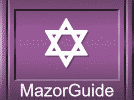

Today is:


  Today is: |

 |
| kasher,kosher,kashrut,kosher supervision,kosher directo | |
|
Bar
Mitzvah Preparations: The Tefillin (Phylacteries)
With mysterious black boxes and long flowing leather straps, tefillin have an otherworldly look about them. Even their origins are cloaked in mystery. No specific instructions are given in the Torah as to the look or content of the tefillin. The distinctive box and strap combination is a tradition extending all the way back to Moses at Mt. Sinai Wearing tefillin is a mitzvah derived from the words: “And you should bind them as a sign on your hand and they should be as ‘frontlets’ between your eyes.” (Deuteronomy 6:8). Tefillin are a sign of our obligation to love God; a commandment that appears a verse or two before the tefillin instructions. (The whole sequence is part of the shema prayer.) What are frontlets? Webster’s Dictionary defines them as a “band or phylactery worn on the forehead.” What’s Inside Tefillin? Each of the four compartment in a tefillin box contains a small piece of parchment inscribed with a few Torah verses. Most tefillin follow the parchment order set out by Rashi, a medieval commentator. His grandson, Rabbeinu Tam, established a different order. Some people put on tefillin twice, once with Rashi tefillin and once with Rabbeinu Tam tefillin. Regardless of which type of tefillin you use, the Rashi approach is most common, the verses will be the same. One compartment contains the Shema from Deuteronomy 6:4-9. “Here O Israel, the Lord Our God, the Lord is one. And you should love the Lord, your God with all of your hearts and with all of your soul and with all of your ability. And these words that I am commanding you today should be in your heart.” Compartment two is from Deuteronomy 11:13-21. The verses elaborate on the reward that awaits those who love and serve God, and then hints to the punishment allotted to those who don’t. “And it will be is you listen to My commandments that I am commanding you today, to love the Lord, your God, and to serve God with all of your hearts and with all of your souls, then I will give you rain for your land in its season, the early and late rains, and you will gather your grain, your wine and your oil. And I will give you grass in your fields for your animals and you will eat and you will be satisfied. Guard yourself lest your heart becomes deceived and you turn away and worship other gods, bowing down to them….” Compartment three has verses from Exodus 13:1-10. “…And Moses said to the People remember this when you went out of Egypt from the house of bondage, because it was with a strong hand that God removed you from there…” The Torah goes on to command the Jewish people to celebrate Passover in the spring as a remembrance of the spring exodus. Matza eating and not having leavened products in the home are specified as part of the holiday. “And you should tell your children on that day saying: This [Passover] is done because of that which the Lord did to me when I came out of Egypt.” Then tefillin are hinted to with the words “And it should be for you a sign on your hand and a memorial between your eye so that the Torah of God should be in your mouth.” Compartment four furthers this theme with Exodus 13:11-16. God’s role in freeing the Jews from Egypt is to be recalled whenever the tefillin are worn. What are Tefillin Made Of? Scribes write all the tefillin verses with black ink on parchment from a kosher animal. A special dye is used to turn the outer leather boxes black, and the best tefillin boxes are shaped out of one piece of leather. The long leather straps are painted black. Buying Tefillin Take time to find a reliable, well-regarded scribe to write your tefillin. One basic requirement is for the scribe to believe in and observe the mitzvot. Scrupulously written tefillin can last for decades. Putting on Tefillin A set of tefillin includes two boxes, each attached to straps. One is called the tefillin shel yad, hand tefillin. Tefillin shel yad is tightened around the left biceps (but lefties wear them around their right biceps) about heart level. Straps from the shel yad are wound down the arm and across the hand and fingers in a very specific way. The second is called tefillin shel rosh and is worn just above the forehead, but not lower than the hairline. Straps below the knot are left to dangle around the shoulders. Two blessings are pronounced during the tefillin winding. First, the shel yad is strapped onto the biceps. Nothing, such as a shirt sleeve, should come between the tefillin and the skin. Once the straps are wound to wrist level, the first blessing is said.
Then the tefillin shel rosh are tightened around the head, and the second blessing is said. (Some Sephardim say just the first blessing.)
Afterward, the leftover length of the tefillin shel
yad straps are wound around the palm and fingers. Click Here to Search For Bar & Bat Mitzvah Services
|
|
|
Mazor Guides: Wealth of Information and Resources Copyright 1998-2024 MazorNet, Inc. http://www.MazorGuide.com | http://www.MazorBooks.com |